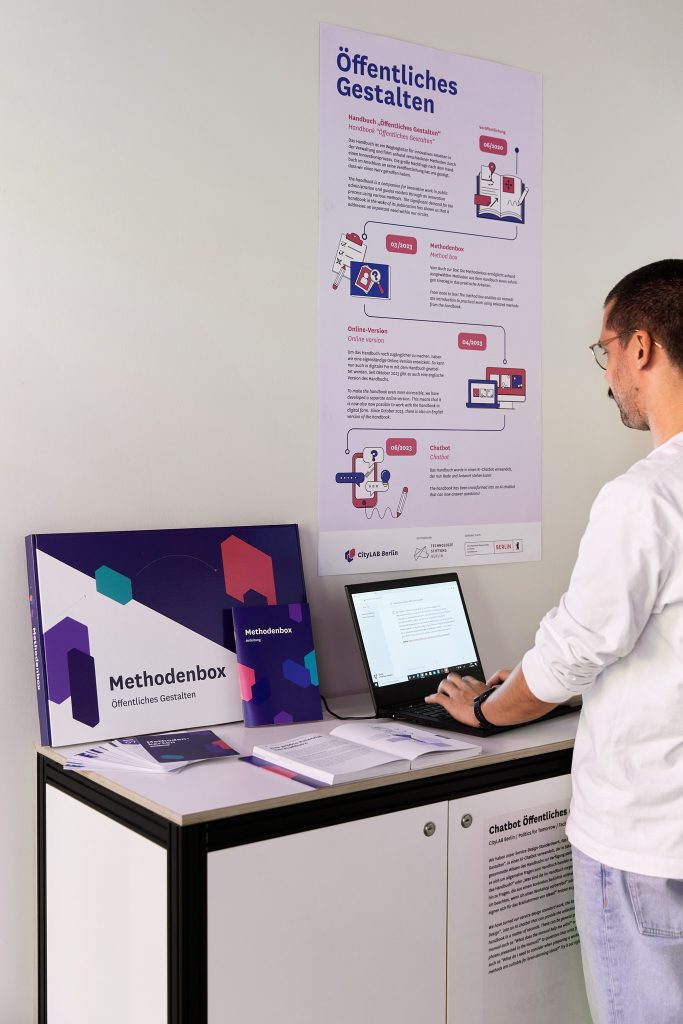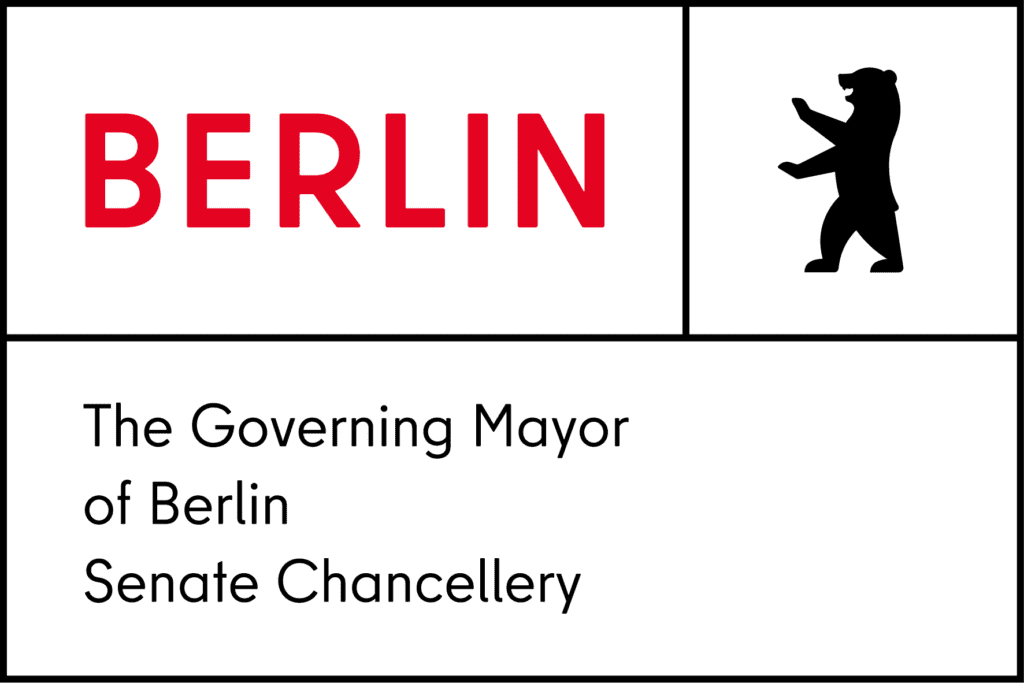The term service design is on everyone’s lips at CityLAB: visitors are greeted in the foyer with methods and examples, and in our exhibition they can explore the materials and resources we have created, such as the Public Design Handbook or the method box, for themselves. But what exactly is behind this term and how can the administration actually benefit from service design methods?
At CityLAB, no one knows this better than our in-house service designers, who use their expertise to guide the administration through innovation processes and digital projects – and also ensure a user-centred approach in our projects. We asked them what inspires them about service design, what experience they have gained in collaborations with the public sector and what advantages they see in it. Here in this interview: Smart City Designer Anja Lüttmann, Service Designer Deborah Paluch, Product and UX Designer Edmundo Galindo, Project Manager Administrative Innovation Lisa Schmechel and Service Designer Tobias Witt.
We start with a mammoth task: What does good service design – initially independent of the administrative context – mean to you in one sentence?
Lisa: Good service design frees itself from expectations and opens up creative space to design processes and services that, in the best case, are not only usable by everyone, but are also fun.
Anja: Good service design thinks holistically and is close to reality: What do people actually do? What is already happening subconsciously? And how can we actively shape this through service design to make tasks easier?
Deborah: Good service design is when people, regardless of their means and abilities, can find and perform the service they need. Ideally, the process is as seamless as possible.

How is service design lived at CityLAB – where is it used in our work?
Tobias: From start to finish. We want to think holistically throughout the entire process, from the enquiry, the first contact, the initial ideas to the testing of a prototype, and service design plays an important role alongside the other disciplines at CityLAB. Service design only works if we think and act in an interdisciplinary way. That’s why it’s so important to talk to people, colleagues and everyone involved, to integrate their perspectives and to use service design as an enabler.
Anja: We live and breathe service design – be it through methodical support for innovation projects in the Berlin administration, through active knowledge transfer at events and exhibition formats or with the help of practical experience in workshops. Ultimately, it is important to us to support multipliers in the administration and to enable real project successes.
Deborah: In the LAB, we develop prototypes for civil society and must prioritise the needs of users in order to offer solutions with tangible added value. Regardless of whether it is an improved digital service or the design of a workshop, our aim is always to create a smooth process that is customised to the wishes and abilities of the people concerned.

Inwiefern kann die Verwaltung von Service Design profitieren?
Edmundo: The administration can benefit from the application of service design by designing services in such a way that they become more efficient, user-friendly and customer-centred. Through a user-centred approach, the needs and concerns of citizens can be better understood. Services can be designed to be transparent and accessible, with a focus on user-friendliness and accessibility.
This can increase citizen satisfaction. This helps to strengthen citizens’ trust in the administration and promote the participation of all population groups. At the same time, internal administrative processes can be analysed in order to optimise the efficiency of their work processes and make better use of resources. This leads to improved service quality and greater citizen satisfaction.

Anja: Administrative services are services that need to be designed in a conscious and citizen-centred way. Especially in the increasing complexity of a smart city, in which many actors are involved in processes, it is important to design them in a lean, barrier-free way and from the user’s perspective. However, the administration is not only the provider, but also the user and therefore benefits just as much from good service design. The service designers at CityLAB show how this can be achieved in collaboration with the administration and citizens.
Lisa S.: Administration is primarily focussed on processes, whether in the provision of services to the outside world or in internal processes. The added value of service design – in contrast to the classic approach of process optimisation – lies in the dialogue between different groups. By involving citizens, services are created that meet their needs. Testing ideas and solutions at an early stage is crucial in order to avoid costs for services that do not offer the desired added value. In addition, employees’ experiences and suggestions are often a valuable source for service design approaches, as they know the processes in detail and can contribute ideas that may have been previously overlooked.

Do you have a favourite example outside of CityLAB that sums up the potential of service design for you?
Edmundo: An outstanding example of the application of service design in the field of administration is the ‘Trámites CDMX’ programme in Mexico. This initiative by the government of Mexico City aims to facilitate access to administrative services. Services have been made more user-friendly, both online and in physical locations (citizens’ offices, kiosks or post offices). This ensures that diverse target groups, including people with disabilities or illiterate people, have access to services, be it through personalised care or assistance.
Deborah: I recently came across a street magazine that can be purchased digitally on a smartphone using a QR code: I find the idea of homeless people being able to sell magazines digitally and cashlessly exciting – a logical consequence when fewer and fewer people have coins on them. I can’t judge whether and how sustainable the project really is.
Lisa: My favourite example is packing stations and other pick-up stations, which are becoming more and more widespread. They remove the link to the opening hours and locations of branches and shops. This is practical for many people who, for various reasons, are unable to keep to opening hours or live further away. Packing stations are particularly interesting, as there was first a pilot phase, which was then scaled up following its success.

What excites you personally about working with Service Design in dialogue with the administration time and time again?
Tobias: The exchange with people from the administration is always an enrichment for me and for our work at CityLAB. I see service design as a kind of tool to get in touch with people from the administration on different levels, to develop empathy for challenges and to understand where the causes lie and arise. For me, service design is not just a design approach, but also a large box of methods that enables us to think holistically.
Edmundo: Was mich persönlich immer wieder begeistert, ist die Möglichkeit, durch Service Design im Austausch mit der Verwaltung positive Veränderungen zu bewirken. Der enge Dialog mit den Bürger:innen und die Zusammenarbeit mit verschiedenen Interessengruppen ermöglichen es, Lösungen zu entwickeln, die wirklich auf die Bedürfnisse und Anliegen der Menschen eingehen. Die Vielfalt der Projekte und die Möglichkeit, innovative Ideen umzusetzen, machen die Arbeit mit Service Design in der Verwaltung äußerst spannend und erfüllend.
Lisa: I am always delighted when administrative staff take a liking to service design. In digital administration, you design with everyone in mind and at the same time for everyone, which is not always easy, especially when there are many special cases outside of a standard process. The opportunity to see a process from a different perspective, to analyse and question it in detail, leads to aha-moments that open up new ways of thinking and acting and can ultimately contribute to a more efficient and user-friendly digital administration.
